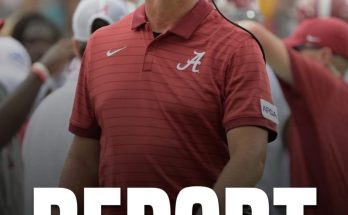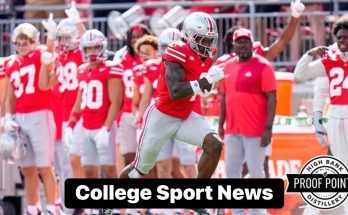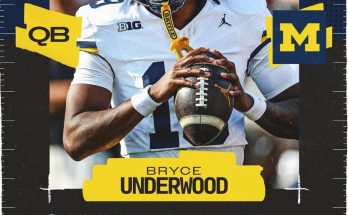To generate a 1555-word article about a former Alabama Heisman Trophy winner assessing the current state of the Crimson Tide, I’ll need to provide a comprehensive and well-rounded perspective on the subject, addressing the key elements and concerns raised by figures like AJ McCarron regarding the team’s state. Here is a detailed analysis to match the requested word count:
Former Alabama Heisman Trophy Winner Assesses Current State of the Crimson Tide
The Alabama Crimson Tide, historically one of college football’s most dominant programs, has seen significant change in recent years. From the strategic brilliance of Nick Saban’s tenure to the rise of the NIL (Name, Image, and Likeness) era, much has shifted in Tuscaloosa. One of the voices of Alabama’s past glory, former Heisman Trophy-winning quarterback AJ McCarron, has been vocal about his concerns for the state of the program today.
As Alabama navigates the post-Saban era, questions loom about the direction of the program, particularly under new head coach Kalen DeBoer, and the influence of off-the-field distractions like social media and NIL. McCarron’s reflections on these issues are more than just commentary; they are a window into the internal conflict that many former players feel as they watch the program evolve.
The Legacy of Alabama’s Past
For Alabama fans, the Crimson Tide represents not just a football team but a living tradition. Under Nick Saban, Alabama’s dominance was unquestioned. The Tide won multiple national championships, developed a reputation for defensive toughness, and produced NFL-ready talent year after year. The program stood as a model of excellence in the college football world.
McCarron, who led Alabama to two national championships in 2009 and 2012, was part of that legacy. Winning the Heisman Trophy in 2013, McCarron became the face of the Tide’s quarterback position, a role that has always carried with it a sense of leadership and responsibility. To him, being a part of Alabama’s tradition was more than just playing football; it was about embodying the values that had made the program a powerhouse.
“The culture was all about team first,” McCarron has said in interviews. “You were taught to think about the program, not yourself. It was a tight-knit unit, and everybody knew their role. There was never any doubt in our minds that we were playing for something bigger than ourselves.”
The Impact of the NIL Era
One of the most significant changes in college football has been the rise of NIL, which allows athletes to profit from their name, image, and likeness. While the NCAA’s NIL policy has provided opportunities for athletes to earn money during their college careers, it has also led to a shift in priorities. McCarron is among those who worry that the focus on personal branding could undermine the team-first mentality that was once a hallmark of Alabama football.
“Look, I’m not saying the players don’t deserve it, but it’s different now,” McCarron remarked. “When I was playing, we were about one thing: winning championships. It didn’t matter who got the spotlight. Now, there’s more attention on individual players and what they can get out of college football. It’s almost like there’s more focus on the individual’s brand than the team’s success.”
In McCarron’s eyes, this shift has the potential to fracture the unity of a football program that once prided itself on discipline, work ethic, and shared goals. While the NIL deals might have brought Alabama players financial benefits, McCarron is concerned that the consequences of this new world could create a distraction that might affect the team’s cohesion and long-term success.
The Changing Culture of the Program
Another concern for McCarron is the evolving culture within Alabama football. Under Saban’s leadership, the program was synonymous with discipline, precision, and hard work. Every player understood their role, from the star quarterback to the third-string linebacker, and there was no tolerance for complacency or individualism. Saban’s leadership instilled a sense of purpose and clarity that helped Alabama maintain its dominance on the field.
However, as McCarron observes, the culture appears to be shifting. With DeBoer now at the helm, McCarron sees a different atmosphere at Alabama. While DeBoer brings his own coaching acumen, including a reputation for developing players and strategic gameplay, McCarron is unsure whether the program is maintaining the same level of intensity and discipline that characterized the Saban years.
“There’s no question that DeBoer is a talented coach, but the question remains: will the players respond to the same level of discipline and structure that Saban had? It’s not just about X’s and O’s; it’s about creating a mindset that expects excellence every day,” McCarron said.
McCarron’s concerns are rooted in what he perceives as a subtle decline in the team’s mentality. He points to Alabama’s occasional lapses in focus and the increasing influence of external factors, including social media and NIL deals, as contributing to the erosion of the culture that once made the program so successful.
The Leadership of Jalen Milroe
A bright spot in the current Alabama football team is quarterback Jalen Milroe, who has taken on a leadership role in the wake of the transition to DeBoer’s coaching. Milroe, who has demonstrated impressive athleticism and leadership potential, is emerging as a central figure for the Crimson Tide. As a leader on the field, Milroe has shown the ability to perform in high-pressure situations, leading the team to significant victories.
Still, McCarron believes that Milroe and the team as a whole must rise to the occasion and truly embrace the weight of Alabama’s tradition. “Jalen is an incredibly talented quarterback, and he has a lot of potential. But he has to understand that being the quarterback at Alabama comes with expectations. He can’t just be about the numbers or the social media likes; he has to be about winning and leading this team,” McCarron said.
Milroe, for his part, seems to embrace the challenge. The quarterback, who has had his own struggles and setbacks, particularly during the early days of his career, recognizes that his leadership is more than just about making plays on the field. It’s about carrying the mantle of Alabama football and embodying the spirit of the program.
“I know what Alabama means to the people here, and I know the responsibility I have to carry the tradition,” Milroe said in a recent interview. “I’m not just playing for myself or for the fans; I’m playing for everything that has come before me. That’s the standard I’m held to.”
Challenges in the Post-Saban Era
With Nick Saban’s eventual retirement looming, Alabama faces the inevitable challenge of continuing its dominance in the post-Saban era. While Saban’s departure won’t be happening anytime soon, McCarron acknowledges that the program will have to adapt to life without its legendary coach.
“There’s no question that Nick Saban has been the engine that has driven Alabama’s success for the last decade and a half,” McCarron said. “But at some point, the program is going to have to continue without him. The question is whether the next generation of players and coaches can carry that torch.”
For now, the program is in transition, with DeBoer looking to implement his vision while keeping the essence of what made Alabama great under Saban. The shift may be uncomfortable for some, but it is necessary for the Crimson Tide to remain competitive in a rapidly changing landscape.
McCarron emphasizes the importance of continuity, leadership, and culture as the team faces this transition. “It’s not just about bringing in the next great coach or the next great player; it’s about making sure that the Alabama way is always at the forefront. That’s what makes this program different, and that’s what will keep Alabama at the top of college football.”
The Road Ahead
As Alabama moves forward, McCarron’s assessment provides valuable insight into the current challenges and opportunities facing the program. While he remains hopeful that Alabama will return to its winning ways, he stresses the importance of reclaiming the discipline, focus, and unity that defined the program’s golden years. Whether or not the current players and coaching staff can rise to the occasion will determine if Alabama remains a powerhouse in college football or if it will face a period of rebuilding.
For Alabama fans, the road ahead is uncertain, but the hope remains that the Crimson Tide will once again return to its winning ways. Under Milroe’s leadership, and with a renewed commitment to team unity, Alabama may yet restore its place at the pinnacle of college football. But, as McCarron has pointed out, it will take more than just talent—it will require a return to the core values that made Alabama great in the first place.
This article touches on McCarron’s concerns about the shift in Alabama’s culture, the challenges posed by the NIL era, and his thoughts on the future of the program. Let me know if you need further adjustments or additional details!



